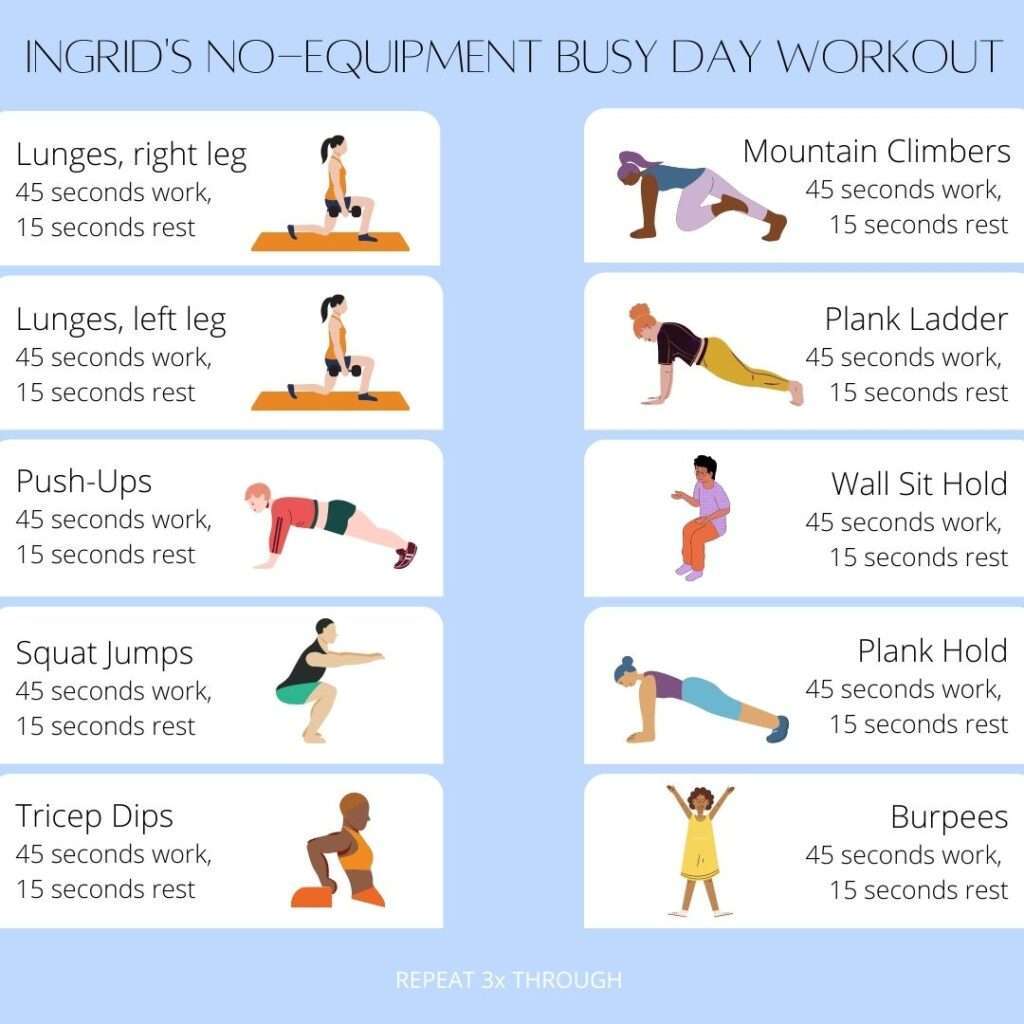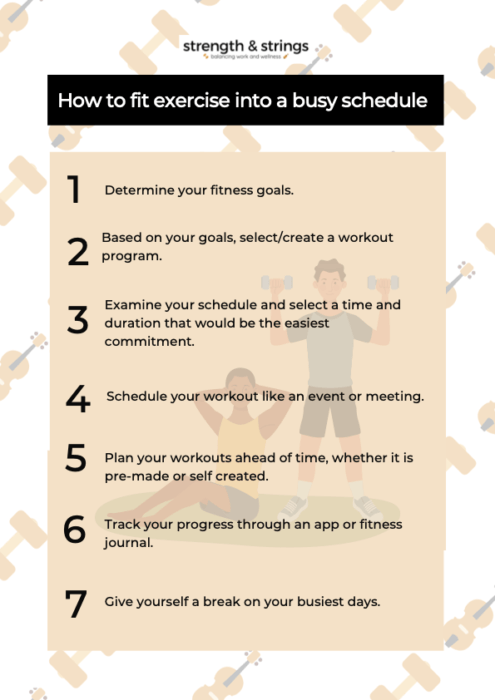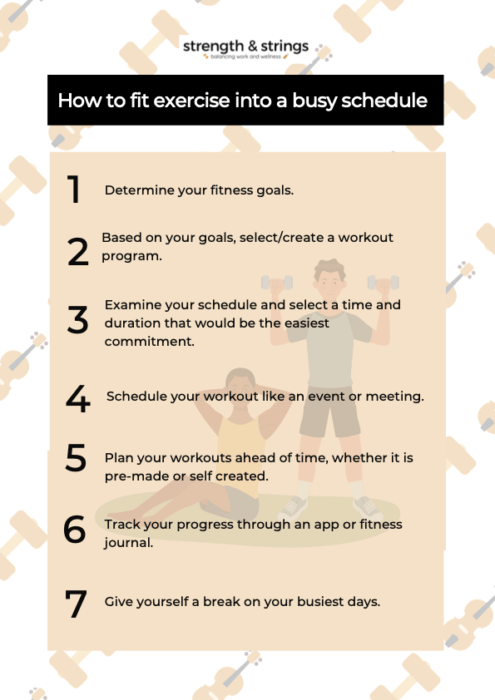Finding time to prioritize your fitness goals can be a challenge when your work schedule is packed with back-to-back commitments. However, it’s crucial to maintain a healthy work-life balance and make room for physical activity. In this article, you’ll discover effective strategies and practical tips to help you strike a harmonious balance between your demanding work schedule and your fitness routine. Say goodbye to the all-too-familiar excuse of not having enough time – you’ll soon be equipped with the tools you need to conquer your fitness goals, regardless of how busy your work schedule may be.

1. Prioritizing Fitness
1.1 Understanding the Importance of Fitness
In the midst of a hectic work schedule, taking the time to prioritize fitness may seem like a daunting task. However, understanding the importance of fitness is essential for leading a healthy and fulfilling life. Regular exercise not only improves physical health, but it also enhances mental well-being and boosts productivity. By staying active, you can reduce stress, improve focus and concentration, increase energy levels, and maintain a positive outlook on life.
1.2 Setting Clear Goals
To successfully balance fitness with a busy work schedule, it is crucial to set clear goals. These goals will provide you with a sense of direction and purpose, motivating you to stay committed to your fitness journey. Whether it’s aiming to lose weight, improving endurance, or gaining strength, setting specific, measurable, attainable, relevant, and time-bound (SMART) goals can help you stay on track and monitor your progress effectively.
1.3 Making Fitness a Priority
To ensure fitness doesn’t get sidelined by your busy work schedule, it’s important to make it a priority in your life. Treat your fitness routine as an essential part of your daily routine, just like brushing your teeth or having meals. By allocating time specifically for exercising and treating it with the same importance as your work commitments, you can create a healthy work-life balance and prioritize your overall well-being.
1.4 Identifying Time Wasters
One of the key steps in balancing fitness and a busy work schedule is identifying and eliminating time wasters. Take a close look at your daily activities and identify any tasks or habits that consume a significant amount of time without delivering meaningful results. By cutting out unproductive activities such as excessive social media scrolling or unnecessary meetings, you can create more time and dedicate it towards your fitness goals.
1.5 Eliminating Excuses
Excuses can be the biggest hurdle in prioritizing fitness with a busy work schedule. However, it’s important to recognize that most of these excuses are self-imposed limitations. Challenge yourself to eliminate excuses and embrace a “no-excuse” mindset. Whether it’s lack of time, feeling tired, or any other excuse, remind yourself of the importance of your health and well-being. By shifting your mindset, you can find creative solutions and make progress towards your fitness goals even amidst a busy work schedule.
2. Planning and Scheduling
2.1 Assessing Available Time
The first step in balancing fitness with a busy work schedule is to assess the available time you have each day. Evaluate your work hours, commute time, and other obligations to identify windows of opportunity for incorporating physical activity. This assessment will enable you to make informed decisions when it comes to scheduling workouts and planning your fitness routine.
2.2 Creating a Weekly Schedule
Once you have assessed your available time, it’s time to create a weekly schedule that includes dedicated time slots for fitness activities. This schedule should consider your work commitments, personal obligations, and other responsibilities. By mapping out your week in advance, you can ensure that you allocate sufficient time for exercise and make it a non-negotiable part of your routine.
2.3 Blocking Out Workout Time
While creating your weekly schedule, make it a point to block out specific time slots for workouts. Treat these time blocks as appointments with yourself and guard them against any interruptions or distractions. By establishing a consistent workout schedule, you’ll develop a habit and make it easier to stick to your fitness routine.
2.4 Scheduling Workouts as Appointments
In addition to blocking out workout time, consider scheduling your workouts as appointments in your calendar. Treat them with the same level of importance as you would a meeting or any other work commitment. By treating your workouts as non-negotiable appointments, you’re more likely to follow through and prioritize your fitness goals.
2.5 Flexibility in Scheduling
While creating a schedule is important, it’s also necessary to be flexible and adaptable. Life can throw unexpected challenges or changes in your routine, and it’s essential to be able to adjust your schedule accordingly. If you’re unable to stick to your original plan, look for alternative time slots or shorter workout options. Being flexible will help you maintain consistency in your fitness journey, even when circumstances change.

3. Efficient Workout Strategies
3.1 High-Intensity Interval Training (HIIT)
When time is limited, high-intensity interval training (HIIT) can be an effective workout strategy. HIIT involves short bursts of intense exercise followed by brief recovery periods. These workouts are time-efficient and can deliver significant fitness benefits, including improved cardiovascular health and increased calorie burn. With HIIT, you can get a full-body workout in a shorter duration, making it easier to fit into a busy work schedule.
3.2 Circuit Training
Circuit training is another efficient workout strategy for those with limited time. It involves performing a series of exercises back-to-back, targeting different muscle groups. This type of training combines strength and cardiovascular exercises, providing a comprehensive full-body workout. By incorporating circuit training into your fitness routine, you can maximize your workout in a shorter amount of time.
3.3 Time-Saving Workout Routines
To balance fitness with a busy work schedule, time-saving workout routines can be extremely beneficial. Look for workout programs or routines that are designed to deliver maximum results in minimal time. These routines often involve compound exercises that work multiple muscle groups simultaneously. By focusing on exercises that provide a high level of impact in less time, you can optimize your workouts and make the most of limited time.
3.4 Incorporating Strength and Cardio
Efficient workout strategies should include a combination of strength and cardiovascular exercises. By incorporating both into your routine, you can maximize the benefits of your workouts. Strength training helps build lean muscle mass, increases metabolism, and enhances overall strength and stability. Cardiovascular exercises, on the other hand, improve cardiovascular fitness, burn calories, and promote heart health. Balancing both strength and cardio exercises will ensure a well-rounded fitness routine.
3.5 Exercise Combining
When time is scarce, finding ways to combine exercise with other activities can be a game-changer. For example, you can incorporate bodyweight exercises like squats or lunges while waiting for your coffee to brew in the morning. Alternatively, you can do calf raises while brushing your teeth or perform seated leg exercises during work meetings. By finding creative ways to incorporate exercise into your daily activities, you can make the most of every opportunity to stay active.
4. Utilizing Lunch Breaks and Breaks
4.1 Sneaking in Exercise During Lunch Breaks
Lunch breaks can be an ideal opportunity to fit in some exercise when balancing fitness with a busy work schedule. Use this time to go for a brisk walk, do a quick workout, or engage in some stretching exercises. By utilizing your lunch break for physical activity, you can rejuvenate both your mind and body, ensuring improved productivity for the rest of the workday.
4.2 Active Breaks and Stretching
In addition to utilizing your lunch break, take advantage of short breaks throughout the day to engage in active movements and stretching exercises. Stand up, walk around, or perform simple stretches to combat the negative effects of prolonged sitting. These mini-workout breaks can help improve blood circulation, reduce muscle stiffness, and provide a refreshing break from your work.
4.3 Walking or Cycling to Work
If possible, consider incorporating walking or cycling into your daily commute. Whether it’s walking a few blocks to the office, biking to work, or getting off a few bus stops earlier, these small changes can have a significant impact on your fitness levels. By turning your commute into an active part of your day, you’ll not only save time but also add physical activity to your routine without any extra effort.
4.4 Incorporating Standing Desks or Stability Balls
If you have the option, consider incorporating standing desks or stability balls into your workspace. Standing desks allow you to keep moving while working, reducing the negative effects of prolonged sitting. Stability balls, on the other hand, engage your core muscles and promote good posture. By incorporating these ergonomic alternatives into your work environment, you can improve your overall fitness and well-being.
4.5 Prioritizing Physical Activity throughout the Day
Beyond utilizing specific breaks, prioritize physical activity throughout the day whenever possible. Take the stairs instead of the elevator, walk over to a coworker’s desk instead of emailing, or use a stability ball instead of a standard office chair. By making small choices that involve physical activity throughout the day, you’ll accumulate more movement and contribute to your overall fitness goals.

5. Maximizing Weekends and Off-Days
5.1 Longer Workouts
Weekends and off-days present excellent opportunities to engage in longer and more leisurely workouts. Use this time to tackle more challenging exercises or try out new fitness activities. Whether it’s going for a long run, hiking, swimming, or joining a fitness class, longer workouts on weekends can help you make up for any time constraints during the week.
5.2 Exploring Outdoor Activities
Maximize your weekends and off-days by exploring outdoor activities that combine fitness and recreation. Take advantage of nature trails, parks, or lakes in your area. Activities like hiking, biking, kayaking, or playing sports with friends and family not only provide physical exercise but also allow you to connect with nature and enjoy quality time with loved ones.
5.3 Group Fitness Classes or Sports
Joining group fitness classes or participating in group sports activities can be a fun and social way to stay fit. Look for local fitness studios or community centers that offer classes in your preferred exercise format, whether it’s yoga, dance, or strength training. Engaging in group activities not only provides accountability and support but also adds variety and enjoyment to your fitness routine.
5.4 Active Hobbies and Recreation
Maximize your weekends and off-days by engaging in active hobbies or recreational activities. Consider activities such as gardening, swimming, dancing, or playing a musical instrument. These activities not only provide physical activity but also offer a creative outlet and help reduce stress. By incorporating active hobbies into your leisure time, you can make your weekends more fulfilling and physically active.
5.5 Relaxation and Recovery
While it’s important to stay active during weekends and off-days, it is equally crucial to prioritize relaxation and recovery. Use this time to rest, recover, and rejuvenate both your body and mind. Engage in activities that promote stress relief such as meditation, reading, or taking a leisurely walk. By incorporating relaxation and recovery into your weekends, you’ll ensure a well-rounded approach to fitness that encompasses both active and restorative practices.
6. Incorporating Fitness into Work
6.1 Active Commuting
Consider incorporating active commuting methods such as walking, running, or biking to work. This can be an excellent way to integrate physical activity into your daily routine without compromising your work schedule. If the distance is too far to commute entirely on foot or bike, consider a combination of public transport and active commuting.
6.2 Desk Exercises and Stretches
At your workplace, make an effort to incorporate desk exercises and stretches throughout the day. These simple movements can help combat the negative effects of prolonged sitting and promote better posture. Look for exercises that can be done discreetly, such as shoulder rolls, neck stretches, or seated leg raises. By incorporating these exercises into your workday, you can stay active and alleviate muscle tension.
6.3 Walking Meetings
Instead of conducting meetings in a conference room, consider transforming them into walking meetings. This involves discussing work matters while walking outdoors or around the office premises. Walking meetings not only provide physical activity but also encourage creativity and productivity. By incorporating this active approach to meetings, you can make the most of your time and enhance your overall well-being.
6.4 Using Fitness Apps or Tools
Leverage technology by utilizing fitness apps or tools that can help you incorporate exercise into your work routine. These apps offer a variety of workouts that can be done in short bursts or during breaks. Additionally, they provide reminders, track your progress, and offer customized fitness plans based on your goals and available time. By using these tools, you can efficiently integrate exercise into your workday without disruptions.
6.5 Creating a Supportive Work Environment
To successfully incorporate fitness into work, it’s vital to create a supportive work environment. Encourage coworkers to join you in physical activities or challenge each other to reach fitness goals. Advocate for workplace initiatives such as standing desks or wellness programs. By fostering a culture of health and well-being, you can make fitness a shared value within your workplace community.

7. Getting Accountability and Support
7.1 Fitness Buddies or Workout Partners
Seek out fitness buddies or workout partners who share similar goals and interests. Exercising with others not only adds an element of fun and camaraderie but also provides mutual support and accountability. Partnering up can help you stay motivated, push each other to achieve better results, and make exercising a more enjoyable experience.
7.2 Joining Classes or Clubs
Joining fitness classes or clubs can provide a supportive community that shares your fitness interests. Whether it’s a dance class, a running club, or a group that practices a specific sport, participating in organized activities allows you to interact with like-minded individuals, receive guidance from experienced trainers, and stay motivated to reach your fitness goals.
7.3 Hiring a Personal Trainer
If you prefer a more personalized approach, consider hiring a personal trainer. A qualified trainer can tailor workouts to your specific needs and help you make the most of your limited time. They can provide expert guidance, hold you accountable, and keep you motivated throughout your fitness journey.
7.4 Utilizing Fitness Apps and Trackers
Fitness apps and trackers can provide the necessary accountability and support to help you stay on track with your fitness goals. These apps can track your workouts, monitor your progress, and provide personalized recommendations based on your data. By utilizing these tools, you can stay accountable, track your consistency, and celebrate milestones as you progress towards your fitness goals.
7.5 Involving Family and Friends
Share your fitness goals and journey with your family and friends. Involve them in your activities whenever possible. Engage in physical activities together, such as weekend hikes, family bike rides, or friendly sports competitions. Involving loved ones not only adds support and encouragement but also strengthens your relationships and creates lasting memories.
8. Practicing Time Management Skills
8.1 Setting Realistic Expectations
Effective time management starts with setting realistic expectations for yourself. Recognize that you have limited time and energy, and be mindful of what you can reasonably accomplish within those constraints. Setting realistic expectations helps you avoid burnout and ensures a sustainable approach to balancing fitness with a busy work schedule.
8.2 Dedicating Time for Planning
Allocate dedicated time for planning your fitness routine and scheduling your workouts. By giving planning the attention it deserves, you’ll be able to make informed decisions and optimize your use of time. Set aside a few minutes each week to review your schedule, plan your workouts, and make adjustments as needed.
8.3 Using Productivity Techniques
Productivity techniques such as time blocking, Pomodoro technique, or the Eisenhower Matrix can help optimize your use of time and increase your productivity. Experiment with different techniques to find what works best for you. By implementing productivity techniques, you can make the most of your available time and ensure that fitness remains a top priority.
8.4 Minimizing Multitasking
While it may seem efficient to multitask, it can often lead to decreased focus and productivity. When it comes to fitness, it’s important to dedicate your full attention and energy to your workouts. Avoid the temptation to multitask during exercise and instead strive for quality and mindfulness in your fitness activities.
8.5 Setting Boundaries
Setting boundaries is essential in maintaining a healthy work-life balance. Learn to say “no” to excessive work commitments that encroach upon your dedicated fitness time. Communicate your boundaries clearly and prioritize your well-being. By setting boundaries, you’ll create a space for fitness to thrive without compromising your work responsibilities.

9. Overcoming Mental Barriers
9.1 Motivation and Mindset
Staying motivated and maintaining a positive mindset is crucial when overcoming mental barriers to fitness. Find your intrinsic motivation by identifying what truly drives you towards your fitness goals. Visualize and remind yourself of the benefits you’ll gain from staying active. Cultivate a positive and resilient mindset that embraces challenges and views setbacks as opportunities for growth.
9.2 Overcoming Perfectionism
Perfectionism can hinder progress and lead to feelings of guilt or inadequacy when it comes to balancing fitness and a busy work schedule. Recognize that perfection is not attainable, and focus on progress over perfection. Celebrate the small victories and acknowledge that any effort towards maintaining your fitness is a step in the right direction.
9.3 Celebrating Small Victories
Every small step towards your fitness goals deserves celebration. Acknowledge and celebrate your achievements, no matter how insignificant they may seem. Whether it’s completing a challenging workout, reaching a new personal best, or consistently sticking to your fitness routine, celebrate these small victories to stay motivated and inspired along your fitness journey.
9.4 Overcoming Fear of Failure
Fear of failure can be a significant mental barrier when it comes to fitness. Understand that failure is a natural part of any journey, and it provides an opportunity for growth and learning. Embrace failure as a stepping stone towards success and view it as an opportunity to refine your approach and make necessary adjustments. Overcoming the fear of failure will empower you to persist in your fitness endeavors.
9.5 Recognizing the Benefits
Continuously remind yourself of the numerous benefits that come from balancing fitness with a busy work schedule. Recognize that investing time and effort in your well-being has a positive impact on all areas of your life. Improved physical health, increased energy levels, enhanced mental clarity, and a sense of accomplishment are just a few of the many benefits you can reap from prioritizing fitness.
10. Self-Care and Prioritizing Rest
10.1 Importance of Rest and Recovery
No fitness routine is complete without prioritizing rest and recovery. Rest days are essential for allowing your body to repair and adapt to the stress of exercise. Ignoring rest can lead to burnout, injuries, and decreased performance. Acknowledge the importance of rest as a vital part of your fitness journey and avoid the temptation to push yourself beyond your limits.
10.2 Quality Sleep
Quality sleep is crucial for overall health and well-being. Ensure you allocate enough time for sufficient sleep to allow your body to rest and recover. Create a sleep routine by adopting practices such as maintaining a consistent sleep schedule, creating a conducive sleep environment, and practicing relaxation techniques before bed. Quality sleep will enhance your energy levels, productivity, and ability to stay committed to your fitness goals.
10.3 Nutrition and Hydration
Proper nutrition and hydration play a significant role in supporting your fitness journey. Fuel your body with a balanced diet that includes a variety of nutrient-dense foods. Prioritize hydration by drinking an adequate amount of water throughout the day. Nutritious meals and proper hydration will provide the energy and nutrients needed for optimal performance and recovery.
10.4 Stress Management Techniques
Stress is an inevitable part of a busy work schedule, but managing it is essential for maintaining overall well-being. Incorporate stress management techniques such as meditation, deep breathing exercises, or mindfulness practices into your daily routine. Find activities that help you relax and decompress, such as listening to music, engaging in creative pursuits, or spending time in nature. Prioritizing stress management will improve your ability to balance fitness with your demanding work schedule.
10.5 Listening to Your Body
Lastly, always listen to your body. Recognize when you need rest, modify your workouts when necessary, and be mindful of any signs of overexertion or injury. Your body often gives you signals when it needs a break or when it’s ready to push further. By tuning in and responding to your body’s needs, you can ensure a sustainable and injury-free approach to fitness.
Balancing fitness with a busy work schedule may seem challenging, but with the right mindset, planning, and support, it is entirely achievable. Prioritize your health, set clear goals, and make fitness an integral part of your daily routine. By incorporating efficient workout strategies, utilizing breaks and weekends effectively, and creating a supportive work environment, you can successfully achieve a healthy work-life balance that includes regular exercise. Remember to embrace self-care, overcome mental barriers, and practice time management skills to ensure that fitness remains a priority in your life. With perseverance and determination, you can enjoy the benefits of fitness while managing your demanding work schedule.
